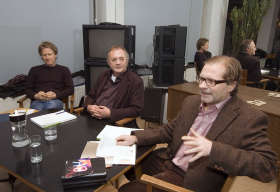KOPFSTAND 09 – A Presentation of Linz09

from right to left: Peter Androsch, Artistic Director Music, Linz09, Wolfgang Gratt, acoustical engineer, Florian Sedmak, Project Director "Hörstadt" / "Audible City", Linz09
Copyright: Linz09
Download Press Photos
Monday, November 26, 2007, 8 PM
transpublic – Institute for Urban Research and Design
Hahnengasse 3 (on Alten Markt), 4020 Linz
The event was initiated by Peter Androsch, Linz09’s musical director whose program concept is focusing on, among other elements, acoustic space as audible life-setting, and Florian Sedmak, director of the “Hörstadt” project.
Wolfgang Gratt, expert in the field of technical acoustics, author of the noise pollution handbook published by the Austrian Federal Ministry of Agriculture, Forestry, Environment and Water Management, and consultant with extensive experience in the planning and implementation of major noise reduction projects in Austria, offered wide-ranging insights into the phenomenon of noise.
Noise can be described succinctly as annoying, disruptive sound, and this isn’t necessarily connected to volume alone; after all, even the sound made by a dripping faucet can be perceived as noise. Gratt clarified a number of points: the maximum number of decibels allowable in order to assure a “good night’s sleep,” at what point hearing impairment can be expected, and the situation with respect to noise abatement guidelines. Those planning to implement measures in this connection have to keep in mind that the effect on noise is computed logarithmically: to cut noise in half, sound has to be reduced by 90%!
The No.1 cause of noise in Linz is vehicular traffic. Acoustically pleasant living conditions can be achieved only through efficient construction measures and effective zoning regulations. Unfortunately, the legal situation in Austria is highly problematic since there’s no single law dealing exclusively with noise; instead, there are lots of pieces of legislation that touch upon this phenomenon.
The audience was especially interested in Gratt’s remarks on the subjects of soundproof windows and architectural possibilities to reduce sound reflection. First and foremost, the field of interior design already offers numerous ways of decreasing noise, which, in schools for example, can create a much more pleasant environment and enhance pupils’ ability to concentrate.
Regrettably, the speaker also had to report that much too little is taught to architecture students on the subject of acoustics, which, as a field of study in its own right, isn’t even offered in Austria. Peter Androsch has made a commitment to remedying this situation and making Linz’s university the first in Austria to offer an acoustics program.





